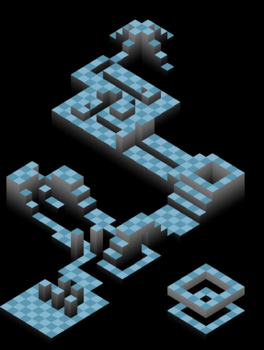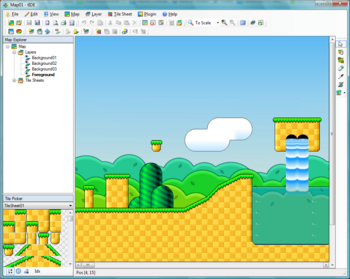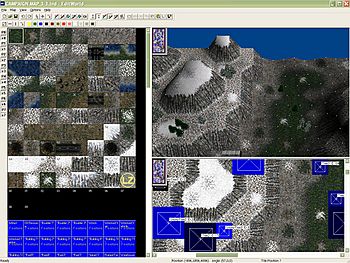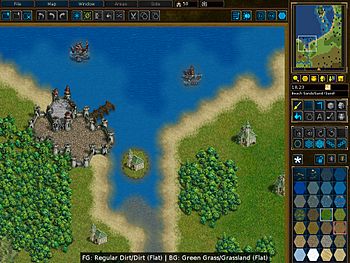Level (video games) facts for kids
In video games, a level is a special area where you play to reach a goal. You might also hear levels called a map, stage, or round. Levels usually get harder as you go, so players of all skill levels can enjoy the game. Each new level often brings new ideas and challenges to keep things exciting!
Sometimes, levels are like different parts of a bigger world, such as the famous Green Hill Zone. Other times, levels are connected, like different rooms in a building. While many games challenge you to defeat enemies, some levels focus on movement. Think of a jumping puzzle or an obstacle course. Here, you need to jump carefully between platforms to get to the next spot. These can be tricky, even in fast action games!
Contents
Designing Game Levels
Level design is all about creating these game worlds, stages, or missions. People who do this are called level designers. They often use special computer programs called level editors. These tools help them build the game's environment. Some games even let players create their own levels using built-in tools!
-
In games with 3D computer graphics like Nexuiz, levels are designed in three-dimensional spaces.
How Level Design Started
In the early days of video games (from the 1970s to the 2000s), one programmer often made all the maps and layouts. There wasn't a special job just for level design yet. Early games often had levels that just got harder and harder. For example, in Space Invaders (1978), every level looked the same but the aliens moved faster.
Other games, like Donkey Kong (1981), used different levels to tell a story. As Mario (who was first called Jumpman) tried to save Pauline, each level was unique. Mario had to complete a different challenge each time until he finally faced Donkey Kong.
Some games even came with tools for players to make their own levels. Lode Runner (1983) was one of the first games to include a level editor. Its creator, Doug Smith, even paid kids in his neighborhood to design levels for the game!
How Levels Are Made Today
Making a level for a modern game usually starts with ideas and drawings. These ideas then turn into detailed plans. Level designers use a level editor to build the environment and place game items. These items can be characters, enemies, or special objects.
A level editor can be a powerful tool, sometimes as complex as professional 3D design software. The steps to create a map can change a lot depending on the type of game.
Here are some general steps:
- Building the big picture: This includes making hills, cities, rooms, or tunnels for players and enemies to move through.
- Setting the rules: Deciding if it's day or night, what the weather is like, how players score points, what weapons are allowed, and if there are time limits.
- Adding special areas: Marking spots where players can gather resources or build bases.
- Placing interactive parts: Adding doors, keys, buttons, teleporters, or secret passages.
- Putting in game items: Placing players, enemies, ladders, coins, weapons, and save points.
- Setting start and end points: Deciding where players begin and finish the level.
- Making it look good: Adding textures, sounds, animations, lighting, and music.
- Creating events: Setting up moments where something happens when a player does a certain action.
- Guiding characters: Telling computer-controlled characters where to walk and what to do.
The first level of a game is often designed to teach players how the game works. A great example is World 1-1 in Super Mario Bros., which teaches you how to jump and hit blocks without needing a tutorial.
Level designers work to make levels fun and easy to understand. They want players to have a great time and feel like they are truly in the game's world.
Guiding the Player
Level designers think about how to guide players through a level without them getting lost. This is called "flow control."
Here are some ways they do it:
- Placing items: Putting power-ups or items in a way that naturally leads the player in the right direction. This is common in platformer games.
- Using light and color: Making important paths or objects brighter or a different color to catch the player's eye.
- Creating clear paths: Using obstacles or environment details to show the player where to go.
- Encouraging exploration: In strategy games, maps are designed to make players leave their base and interact with others.
Seamless Loading
In older games, when you finished a level, the game would stop and show a loading screen. This was because the game had to load all the information for the next level.
Today, with faster computers and game consoles, games can load new parts of the level as you play. This is called level streaming. It means you can move from one area to another without seeing a loading screen. This is especially useful in open world games, making the world feel huge and connected.
Sometimes, games use tricks to give the computer time to load. For example, your character might walk slower during a story moment. Or you might go through a "loading tunnel" where your view is limited, allowing the game to load the next area in the background. Newer consoles are so fast that they can often load everything instantly, making these tricks less necessary.
What a Level Designer Does
A level designer is a game designer who creates game environments and challenges. They use level editors and other tools. Level designers often work on a level from start to finish, even when the game is still being made.
Video game programmers usually create the level editors for designers to use. This means designers don't need to change the game's computer code. Level designers often start with simple shapes and ideas to make sure the level works well before artists add all the detailed graphics. Many level designers are good at both art and game design.
Tools for Creating Levels
Level designers use many different tools. While they might use general design software for models and textures, games often need data in a special format for their specific game engine. So, they use special programs to convert models, textures, and sounds.
Sometimes, professional 3D design software like Blender or Maya is used. These programs often have special add-ons made just for the game they are working on.
Level Editor Explained
A level editor (also called a map editor or scenario editor) is a tool used to design levels, maps, and virtual worlds for a video game. The person who uses it is a level designer.
Sometimes, game creators include level editing tools right in the game. For example, a racing game might have a track editor. Other times, they release a separate official level editor. Players can even create their own fan-made level editors!
Making a good level editor takes a lot of time. So, game developers often use the same game engine and editor for many games. This saves time and money.
One of the first 3D games to become super popular partly because of its level editors and fan-made maps was Doom. Players created tons of new levels, which helped build a big online community.
-
TIDE level editor showing tiles for a side scroller game.
Construction Sets
In the early days of gaming, some games came with something called a "construction set." This was similar to a level editor. Some games used them to make extra levels, while others, like the Shoot-'Em-Up Construction Kit, let you build a whole new game!
How Levels Change Gameplay
The way a map is designed can really change how a game feels. For example, if a map has lots of platforms, it might feel like a platformer game. If it has many buttons, keys, and doors, it might feel more like a puzzle game. Some shooting game maps might avoid long hallways to stop sniping, while others might allow for both sniping and close combat.
Gimmick maps are special levels made to try out one specific part of gameplay, like only sniping or only fist fighting. While these are fun for a short time, they usually aren't included in the final game because they don't offer much replay value.
Minigames
A minigame is a short game found inside a bigger video game. Minigames often have different rules or gameplay than the main game. They might be optional and are usually simpler or smaller. Sometimes, minigames are even given away for free to promote the main game. They can also be bonus stages or secret levels. The main difference is that a level uses the same rules as other levels in the game, but a minigame can have totally different rules and play styles.
Hidden Features
Level designers sometimes hide secret rooms or areas in their levels. These usually take more effort to find or reach. They often give players extra rewards, like ammo or power-ups. Hidden areas encourage players to explore every corner of the map. Sometimes, they are Easter eggs, containing fun messages, the designers' names, or funny pictures. One of the first 3D games with hidden passages was Wolfenstein 3D, where you could push certain walls to find secrets.
Sometimes, a whole level can even be designed as a secret level!
Bonus Stages
A bonus stage (also called a bonus level or bonus round) is a special level in a game designed to reward the player. In these stages, you can usually collect extra points or power-ups. Bonus stages often have no enemies or dangers. If there are dangers, they usually just kick you out of the bonus stage instead of hurting you. Many bonus stages need to be found or unlocked, or they might appear after you finish a certain number of regular levels.
Level Bugs
Level designers try to avoid problems called "map bugs," but sometimes they slip through.
- A player might get stuck in the level and can't move or escape.
- A player might find a spot where they can easily get lots of experience points without much effort.
- In multiplayer maps, a player might reach an area that's not supposed to be accessible, like a rooftop, and unfairly attack other players.
- A player might fall "out-of-bounds" of the map where others can't reach them.
- Sometimes, you might hit an invisible wall that stops you. This can be a bug from an old version of the level or a problem with how an object is set up.
Special tools can help find these problems, but the best way to make a map better is to have experienced players test it out. They can try to find and report any issues!
Famous Game Levels
Here are some well-known levels from video games:
- Green Hill Zone from Sonic the Hedgehog
- World 1-1 and Minus World from Super Mario Bros.
- Blood Gulch and The Silent Cartographer from Halo: Combat Evolved
- No Russian from Call of Duty: Modern Warfare 2
- Milkman Conspiracy from Psychonauts
- Water Temple from The Legend of Zelda: Ocarina of Time
- Robbing the Cradle from Thief: Deadly Shadows
- Inverted Castle from Castlevania: Symphony of the Night
- Effect and Cause from Titanfall 2
- Facing Worlds from Unreal Tournament
- Dust II from Counter-Strike
- Anor Londo from Dark Souls
- All Ghillied Up from Call of Duty 4: Modern Warfare
- 2Fort from several team multiplayer games
See also
 In Spanish: Nivel (videojuegos) para niños
In Spanish: Nivel (videojuegos) para niños
- Online creation
- Mod (video gaming)
- ROM hacking
- List of gaming topics
- Game tutorial







